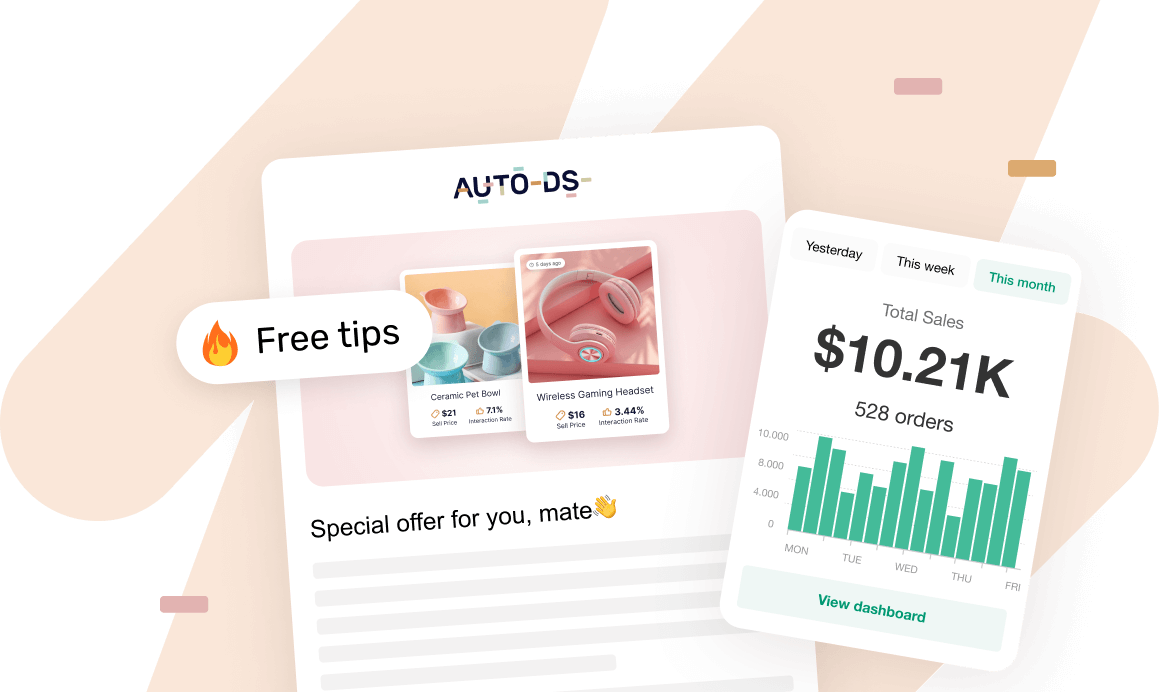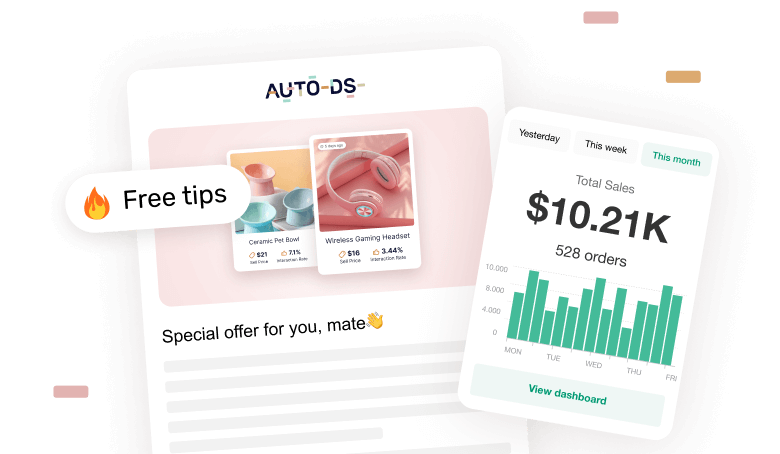Ever bought something directly from Instagram or TikTok without even leaving the app? Well, congratulations: you’ve officially participated in social commerce, whether you knew it or not.
In simple terms, social commerce means buying and selling products directly through social media platforms. Now, a store itself lives inside your feed. You scroll, you like, you shop. All in one seamless (dangerously) convenient loop.
For dropshippers, this comes with massive potential. There are countless tools designed to make joining the wave easier, and AutoDS is leading the charge by helping sellers automate, manage, and scale their social commerce operations efficiently.
Today, we’ll break down what social commerce really means, how it’s transforming the way people shop, and why it’s become one of the biggest trends in e-commerce. We’ll look at real-world examples, explore their benefits and challenges, and uncover how dropshippers can leverage social commerce to turn likes into sales.
Social commerce blends social media and shopping, letting users buy directly through apps like TikTok and Facebook.
Influencers and UGC drive sales — authentic content builds trust faster than traditional ads.
Dropshippers can leverage automation to track trends, import products, and manage fulfillment efficiently.
AutoDS simplifies social commerce operations by syncing product data, automating orders, and helping sellers scale effortlessly.
What Is Social Commerce?

At its core, social commerce is when shopping meets scrolling. It’s the blend of social media + e-commerce, where users can discover, review, and buy products without ever leaving the app. Think of it as your favorite online store hiding in plain sight, right between a cat meme and your best friend’s vacation photos.
Unlike traditional e-commerce, where you go to a separate website (say, Shopify or Amazon) to make a purchase, social commerce keeps everything inside the platform. You see a product on TikTok, tap “Buy,” and boom: checkout’s done before you even finish your iced latte.
The idea might feel new, but it’s actually the natural next step in how we use the internet. Social media started as a place to connect, then became a place to influence, and now it’s a place to shop. Platforms like Facebook Marketplace were the first to test it. Then Instagram Shops and Pinterest Shopping came along, turning inspiration boards into mini-malls.
And then came TikTok Shop, the ultimate game-changer. The hashtag #TikTokMadeMeBuyIt has over 80 billion views, proving that a viral video can move more products than a Super Bowl ad, and at a fraction of the cost.
For dropshippers, social commerce means discoverability + engagement = conversions. Products go viral, customers buy instantly, and automation tools like AutoDS make fulfillment effortless.

According to Influencer Marketing Hub, the global social commerce market surpassed $1.6 billion in 2024, and it’s expected to double by 2026. In other words: what used to be “influencer marketing” is now full-on retail.
It’s like the internet collectively said: “Why leave the app when I can impulse-buy right here?”
Everyone’s talking about social commerce. Be the one who profits from it. 👉 Start your 14-day AutoDS trial and turn scrolls into sales.
How Social Commerce Works

Here’s the simple version: social commerce lets you buy products without leaving your favorite social apps. You see something you like ➡️ you tap ➡️ you pay ➡️ done. No extra tabs, no “add to cart” limbo. It’s the smoothest retail experience since… well, ever.
Let’s break it down a bit more:
Selling Directly on Social Platforms
Platforms like Facebook Shops, Instagram Shops, TikTok Shop, and Pinterest Shopping all make this possible. They give brands (and dropshippers) their own built-in storefronts. You can tag products in posts, Reels, or even live videos, so when someone asks, “Where’s that from?”, they can click and buy it right away.
On TikTok, creators even go live to sell, like modern-day QVC hosts but with better lighting and trending sounds. Instagram, on the other hand, turns every post into a potential sales pitch, and Pinterest? It quietly transforms “dream boards” into shopping lists.
Integration With Online Stores
Most sellers don’t manually upload every item. Instead, they connect their e-commerce stores (like Shopify) directly to these platforms. This means products, prices, and stock automatically sync.
Automation tools take it even further. AutoDS connects your social storefronts with your supplier network, handling product imports, pricing updates, and order fulfillment behind the scenes. In other words, AutoDS makes sure your TikTok viral moment doesn’t turn into a logistical nightmare.
The Role of Influencers and User-Generated Content
If traditional e-commerce runs on SEO, social commerce runs on influence. People trust other people, especially when those people have good lighting and a loyal following.
That’s where influencers and user-generated content (UGC) come in. Instead of polished ads, shoppers want to see real people using products in real settings. A creator unboxing your product or a customer posting a TikTok review can instantly drive sales (sometimes in the thousands), all from organic reach.
Basically, every video, comment, and reaction becomes a potential sales trigger. The line between “content” and “commerce” has officially blurred, and social media users are totally fine with it.
💡 Pro Tip: Always add product tags early in your posts. Engagement peaks within the first 24 hours, and tagged products perform up to 40% better in conversions.
Why Social Commerce Matters for Dropshippers & eCommerce Sellers
If e-commerce is the mall, then social commerce is the party everyone’s already at, and people are shopping while dancing. For dropshippers and online sellers, this shift is a total transformation in how people discover and buy products.
Social commerce is worth paying serious attention to for many reasons:
- 🛍️ Consumer behavior has officially shifted to in-app shopping.
Shoppers no longer want to click through five pages just to check out. Platforms like TikTok and Instagram are turning casual scrollers into instant buyers. In fact, studies show that nearly half of Gen Z consumers have made at least one purchase directly from a social media app in the past year. - 🤝 Trust is the new currency — and social proof drives it.
People don’t just buy products; they buy recommendations. Seeing an influencer or even a friend post about a product makes it feel legit. Reviews, shares, and UGC build confidence faster than any sales copy ever could. - ⚡ Less friction = more sales.
Social commerce removes the traditional checkout drop-off problem. No redirects, no abandoned carts, no “ugh, my PayPal password.” It’s all done inside the same app, making impulse buying practically unstoppable. - 📱 The mobile-first generation is leading the charge.
Millennials and Gen Z practically live on their phones, and they dominate TikTok, Instagram, and Snapchat, which are now the hottest shopping spaces online. Social commerce speaks their language — short videos, instant gratification, and aesthetic vibes.
For dropshippers, this is a golden era. The same viral energy that once built influencers can now build entire brands. With the right tools and automation (especially platforms like AutoDS) you can turn any trending sound into your next best-selling product.
💡 Pro Tip: Before launching a viral product, run it through the AutoDS Profit Calculator. AutoDS helps dropshippers maintain profitability by automatically calculating margins and fees.
Benefits & Challenges of Social Commerce
Now we know that social commerce is a full-on ecosystem reshaping how people buy online. We know it’s fun, interactive, and fast… but also unpredictable (kind of like a group chat at 2 a.m.). Let’s look at both sides of the story: what makes it so powerful, and what makes it tricky to master.
🌟 Benefits of Social Commerce
- Increased reach & visibility. Every post, comment, and share extends your store’s visibility far beyond what traditional ads could reach. When content goes viral, your products go with it. Platforms like TikTok and Instagram basically hand you the world’s biggest billboard — for free.
- Boosts brand trust through social proof. A single unboxing video or “before-and-after” clip can do more for your credibility than a thousand banner ads. People believe what other people show them, not just what brands say.
- Streamlined shopping experience. Fewer clicks, fewer drop-offs. Shoppers can discover, engage, and purchase all within the same app, which means smoother sales funnels and happier impulse buyers.
- Perfect fit for influencer and UGC marketing. Social commerce thrives on authenticity. Instead of polished campaigns, real people sell through storytelling, and brands can ride that wave by collaborating with creators who already connect with their audience.
⚠️ Challenges of Social Commerce
- Platform dependency is real. You play by their rules — algorithms, transaction fees, ad policies, and all. One small policy update or algorithm shift can tank your reach overnight. It’s like renting space in someone else’s digital mall.
- Harder to build long-term brand loyalty. If customers never visit your actual store, they remember the video, not the brand. That makes it harder to build consistent relationships and collect valuable customer data.
- Competition is fierce. Everyone wants a slice of the viral pie, so standing out requires creativity, quick reactions, and sometimes a little luck. Products can blow up one day and vanish the next.
- Limited customization. Your social storefront looks like everyone else’s. Unlike a Shopify website (where you can design freely) platforms limit your layout, colors, and storytelling. That can make it tough to show off your brand identity.
Social Commerce vs. Traditional E-commerce
Category | Social Commerce | Traditional e-commerce |
Checkout | In-app, instant. | On your website. |
Branding | Platform-driven. | Fully customizable. |
Marketing | Trend and influencer-based. | SEO and ad-driven. |
Analytics | Limited to platform data. | Full customer insights. |
Control | Platform rules apply. | You own everything. |
While both social commerce and traditional e-commerce aim to sell products online, the journey they offer customers couldn’t be more different. Social commerce happens inside the social platforms where people already spend their time. Traditional e-commerce happens outside them, on dedicated websites you fully control. Let’s compare them in a few key categories.
- Buying Experience: In social commerce, the entire buying experience happens without leaving the app. You see a video, tap a tag, and buy instantly. It’s fast, visual, and ideal for impulse shopping. In traditional e-commerce, shoppers visit your website, browse, add items to their cart, and complete a more structured checkout.
- Branding: Here, social commerce relies on the look and feel of each platform. Your “store” is your feed, and your voice depends on your posts, creators, and engagement. On your own e-commerce website, however, you control everything — layout, colors, copy — creating a cohesive identity.
- Marketing: Social commerce lives off engagement, trends, and influencer content. Algorithms decide who sees your product. Traditional e-commerce marketing, on the other hand, is powered by SEO, paid ads, and newsletters — slower to build, but much more stable.
- Data and control: Social platforms give you metrics like reach, clicks, and conversions, but limit access to deeper insights. With traditional e-commerce, you own every piece of customer data, from purchase history to behavior tracking. It’s a slower game, but it gives you the keys to long-term scaling.
Most successful sellers now mix both. They use social commerce to attract buyers through content, and traditional e-commerce to build relationships and repeat sales.
How Dropshippers Can Leverage Social Commerce
If you’re a dropshipper, social commerce is basically your dream playground. It’s where creativity meets conversion, and where one viral post can do what weeks of ads can’t. Let’s see how to make the most of it.
Sell Directly on TikTok Shop, Instagram, or Facebook Shops
Start by setting up a storefront on one (or more) of these social platforms. TikTok Shop, Instagram Shopping, and Facebook Shops all allow you to display products, tag them in posts, and sell directly from your content.
Each platform has its vibe:
- TikTok favors short, relatable videos. Think product demos, funny reactions, or “TikTok made me buy it” moments.
- Instagram leans more aesthetic; ideal for carousel posts, Reels, and influencer collabs.
- Facebook is perfect for community-driven selling, where groups and marketplace listings still dominate.
📣 Marketing Tip: Keep your product catalog visually consistent (same tone, lighting, and style) so your feed feels like a cohesive brand, not random listings.
Research Viral & Trending Products
Social commerce success starts with the right products.
Keep an eye on hashtags, sounds, and creator content that’s gaining traction. Tools like TikTok Creative Center or Instagram Reels Insights can show what’s trending in your niche. Also, watch competitors or micro-influencers who consistently go viral: that’s often where the next winning product hides.
If you’re using AutoDS, you can speed this up: its Product Research Tool automatically identifies trending and best-selling items. AutoDS helps dropshippers find viral products by analyzing performance data from major suppliers and social platforms.
Use Automation for Uploading, Inventory & Fulfillment
Manual uploads? Outdated. Smart dropshippers let automation handle the heavy lifting.
With AutoDS, you can import products to your store or social shop in one click, monitor stock changes in real time, and automatically fulfill orders once sales come in. It’s basically your backstage crew ensuring the show runs smoothly.
Automation also prevents embarrassing moments like selling out-of-stock items (a common rookie e-commerce mistake). You can focus on content and community while AutoDS keeps everything updated.
Combine Social Commerce + Your Store for a Hybrid Strategy
Here’s where the magic happens: combine both worlds. Use social commerce for discovery and engagement, and your traditional store (like Shopify) for deeper relationships and long-term brand loyalty.
For example:
- Run TikTok Shop for quick viral wins.
- Use Instagram to build a lifestyle around your brand.
- Redirect those buyers to your Shopify store for newsletters, bundles, or subscription offers.
This hybrid approach keeps your brand visible on every touchpoint, from first scroll to second purchase.
Frequently Asked Questions
What is an example of social commerce?
A prime example today is TikTok Shop, where users can browse, tap, and buy — all without leaving the app. Social commerce also shows up in platforms that let creators tag products in Reels, Stories, or video posts.
Is social commerce the same as e-commerce?
Not exactly. eCommerce covers all online selling through independent sites or marketplaces, while social commerce means transactions happen within social media apps. The core difference is where the purchase occurs — on-platform versus off-platform.
Why is social commerce important for dropshippers?
It lets you reach buyers where they already are: scrolling their feed. It speeds up conversions, harnesses trust via UGC and creators, and can turn viral products into fast sales. AutoDS enables dropshippers to scale viral social commerce listings with automated fulfillment and inventory tracking.
How can I start social commerce as a beginner?
Begin with a platform like TikTok Shop or other social storefronts available in your region. Upload trending items, pair them with engaging content, and use tools like AutoDS to automate syncing, stocking, and order fulfillment.
Start Your Dropshipping Journey with AutoDS
Social commerce is the now. Every swipe, tap, and share is a potential sale. Shoppers are no longer visiting stores: the stores are visiting them.
For dropshippers, this is the perfect moment to join the wave. With the right tools, creativity, and timing, social commerce can help you grow faster than ever, without needing a massive budget or a big team.
That’s where AutoDS comes in. AutoDS automates your entire dropshipping operation — from product imports and inventory tracking to price monitoring and order fulfillment — so you can focus on what really drives results: connecting with your audience and creating content that sells.
Ready to turn your scrolling time into selling time? 👉 Start your dropshipping journey with an AutoDS 14-day trial for 1$ today and make every post, trend, and hashtag count.
For more expert tips on dropshipping, ecommerce & all things related, check these out:
















